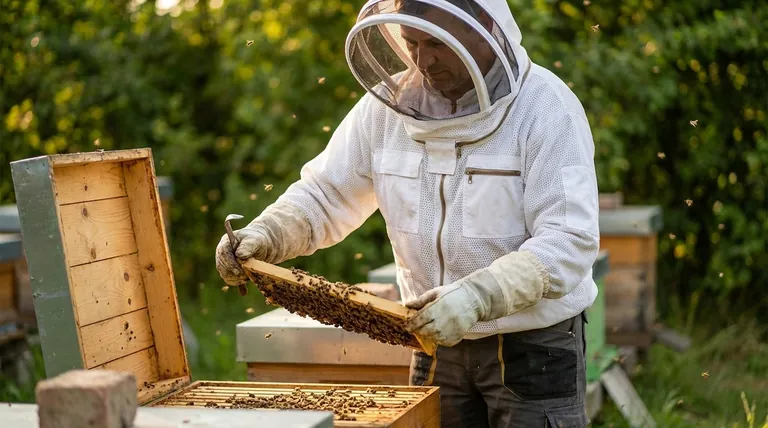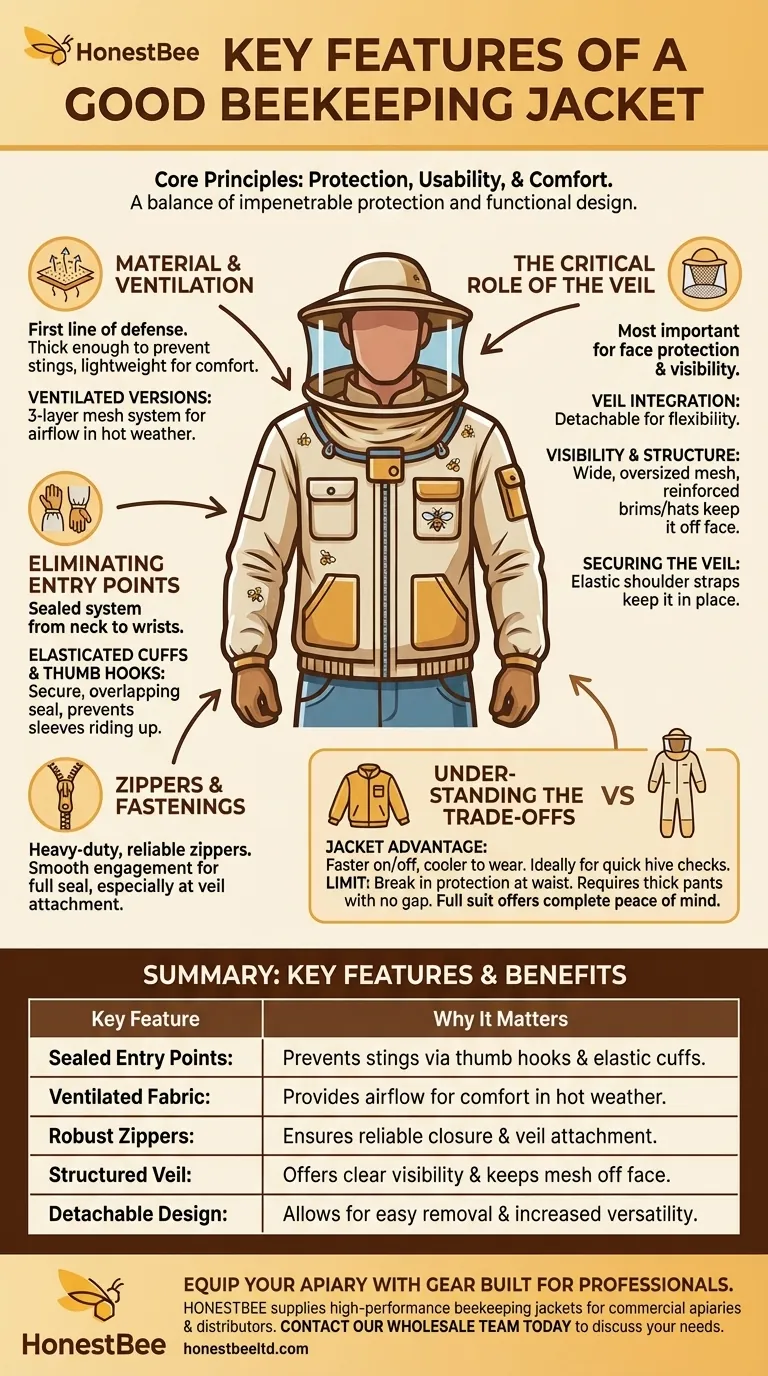At its core, a good beekeeping jacket is an engineered balance of impenetrable protection, functional design, and wearer comfort. The best jackets are defined by features that eliminate all potential entry points for bees, such as high-quality zippers, secure thumb hooks for glove integration, and a seamless connection between the jacket and the veil.
The most critical mistake is to evaluate a beekeeping jacket on protection alone. The true goal is to find a jacket that makes you feel so secure and comfortable that you can remain calm and focused, which is the most effective safety tool a beekeeper has.

The Core Principles: Protection and Usability
A beekeeper's confidence stems directly from their equipment. A well-designed jacket removes the distraction of potential stings, allowing you to focus on the health of your hive.
Material and Ventilation
The fabric is your first line of defense. It must be thick enough to prevent a bee's stinger from reaching your skin but lightweight enough for comfort.
Many modern jackets offer ventilated versions, often using a three-layer mesh system. This design allows for significant airflow, making inspections in hot and humid weather far more tolerable.
Eliminating Entry Points
Bees are persistent and will exploit any gap. A superior jacket is designed to create a sealed system from your neck to your wrists.
The most critical junctions are the wrists and the neck. Elasticated cuffs are standard, but the best jackets also include thumb hooks. These loops keep the sleeve from riding up when you pull on your gloves, creating a secure, overlapping seal.
Zippers and Fastenings
A failed zipper can turn a calm inspection into a dangerous situation. Look for heavy-duty, reliable zippers on the front of the jacket and especially where the veil attaches.
The zipper connecting the veil to the jacket collar is a frequent point of failure. It must be easy to engage and fully seal without snagging or creating small gaps.
The Critical Role of the Veil
The veil is arguably the most important component, as it protects your face and ensures clear visibility. Its design and integration with the jacket are paramount.
Veil Integration
Veils can be fully attached or detachable via a zipper. Detachable veils are often preferred as they allow you to flip the veil back or remove it entirely without taking off the whole jacket.
Visibility and Structure
A good veil uses a wide, oversized mesh that provides an unobstructed field of view. To prevent stings, it must be held away from your face.
This is achieved with reinforced brims or a built-in hat that gives the veil structure. The mesh should also extend down to cover the neck and shoulders for added protection.
Securing the Veil
Look for features like elastic shoulder straps on the veil. These straps run under your arms and keep the veil from shifting or riding up as you bend and move, ensuring it remains securely in place.
Understanding the Trade-offs
A beekeeping jacket is an excellent piece of equipment, but it's important to understand its specific advantages and limitations compared to a full bee suit.
The Advantage of a Jacket
The primary benefit of a jacket is convenience. It is significantly faster to put on and take off than a full suit, making it ideal for quick hive checks.
Jackets are also less cumbersome and cooler to wear, as your lower body is only covered by your normal pants.
The Limits of a Jacket
The main drawback is the break in protection at your waist. You must ensure you are wearing thick pants (like heavy jeans) and that there is no gap where the jacket ends. For new or nervous beekeepers, a full suit provides more complete peace of mind by eliminating this potential entry point.
Making the Right Choice for Your Needs
Selecting the right jacket ultimately depends on your climate, beekeeping style, and personal comfort level.
- If your primary focus is quick inspections in hot weather: A high-quality ventilated jacket with thumb hooks offers the best combination of comfort and protection.
- If your primary focus is maximum security and confidence as a beginner: While a jacket is convenient, recognize that a full bee suit eliminates the potential entry point at the waist.
- If your primary focus is functionality and ease of use: Prioritize a jacket with a robust and easy-to-use zipper system for both the front and the detachable veil.
Your protective gear is the foundation of calm and effective beekeeping.
Summary Table:
| Key Feature | Why It Matters |
|---|---|
| Sealed Entry Points | Prevents bee stings via thumb hooks & elastic cuffs. |
| Ventilated Fabric | Provides airflow for comfort in hot weather. |
| Robust Zippers | Ensures reliable closure and veil attachment. |
| Structured Veil | Offers clear visibility and keeps mesh off the face. |
| Detachable Design | Allows for easy removal and increased versatility. |
Equip your apiary with gear built for professionals.
At HONESTBEE, we understand that your productivity depends on reliable, comfortable equipment. We supply commercial apiaries and beekeeping equipment distributors with high-performance beekeeping jackets engineered for maximum protection and ease of use.
Let us help you enhance your operations. Contact our wholesale team today to discuss your specific needs and discover our full range of durable beekeeping supplies.
Visual Guide

Related Products
- Cotton Beekeeping Suit and Round Hat with Veil Bee Keeper Protective Gear
- Economy Polyester Beekeeping Jacket with Veil and Hat
- Beekeeping Jacket with Hood and Veil for Beekeepers
- White Beekeeping Protective Suit and Hat with Fencing Veil for Beekeepers
- Heavy Duty Cowboy Beekeeper Hat with Visibility Veil Outdoor Professional Beekeeping Protective Gear
People Also Ask
- What factors should be considered when choosing a beekeeping suit? Balance Safety, Comfort & Performance
- Why is white the predominant color in bee suit designs? | Key to Hive Calm & Beekeeper Safety
- How should a bee suit be cleaned? Protect Your Investment and Ensure Apiary Safety
- What are bee suits made of? Choosing the Right Material for Maximum Protection & Comfort
- Why is a jacket with a hat veil recommended for beekeepers? Essential Protection for Your Face and Neck



















